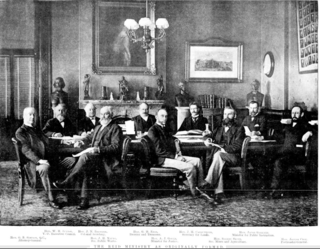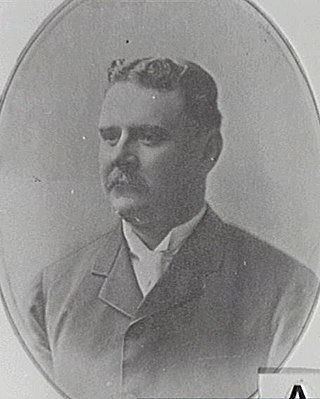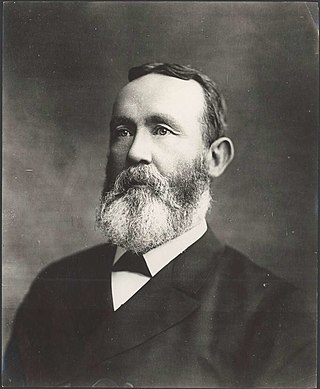Related Research Articles

The Reid ministry was the 28th ministry of the Colony of New South Wales, and was led by the 12th Premier, George Reid. The title of Premier was widely used to refer to the Leader of Government, but was not a formal position in the government until 1920. Instead the Premier was appointed to another portfolio, usually Colonial Secretary but on this occasion Reid took the portfolio of Colonial Treasurer until July 1899 and then Attorney General.

Sir William Patrick Manning was an Australian financier and politician.

Francis Augustus Wright was a merchant sailor, gold miner, carrier and member of the Parliament of New South Wales.
Argyle, an electoral district of the Legislative Assembly in the Australian state of New South Wales, has existed from the establishment of the Legislative Assembly in 1855 until the district's abolition in 1904.
The 1901 New South Wales state election was for 125 electoral districts, with each district returning one member. The election was conducted on the basis of a simple majority or first-past-the-post voting system. In this election, in 32 electorates the winning candidate received less than 50% of the votes, while 13 were uncontested. The average number of enrolled voters per electorate was 2,764, ranging from Wentworth (1,706) to Willoughby (4,854).
The 1894 New South Wales colonial election was for 125 electoral districts, with each district returning one member. The election was conducted on the basis of a simple majority or first-past-the-post voting system. There were three significant changes from the 1891 election, the abolition of multi-member constituencies, the abolition of plural voting where an elector had property or residence in more than one electorate and that polls for every district were held on the same day. The number of seats was reduced from 141 to 125. In this election, in 74 electorates the winning candidate received less than 50% of the votes, while 1 was uncontested. The average number of enrolled voters per electorate was 2,046, ranging from Lismore (1,360) to Marrickville (2,924).
The 1891 New South Wales election was for 141 members representing 74 electoral districts. The election was conducted on the basis of a simple majority or first-past-the-post voting system. In this election there were 39 multi-member districts returning 106 members. In these multi-member districts each elector could vote for as many candidates as there were vacancies. 7 of the 35 single member districts were uncontested. The average number of enrolled voters per seat was 2,166, ranging from Wilcannia (1,023) to Sturt (8,306). Sturt was an anomaly, as enrolments had increased by 5,376 since the 1889 election, and the next largest electorate was Canterbury (4,676).
The 1889 New South Wales colonial election was for 137 members representing 74 electoral districts. The election was conducted on the basis of a simple majority or first-past-the-post voting system. In this election there were 37 multi-member districts returning 100 members. In these multi-member districts each elector could vote for as many candidates as there were vacancies. 10 districts were uncontested. The average number of enrolled voters per seat was 1,955, ranging from Boorowa (1,142) to Canterbury (4,129).
The 1882 New South Wales colonial election was for 113 members representing 72 electoral districts. The election was conducted on the basis of a simple majority or first-past-the-post voting system. In this election there were 32 multi-member districts returning 73 members and 40 single member districts. In the multi-member districts each elector could vote for as many candidates as there were vacancies. 13 districts were uncontested. There was no recognisable party structure at this election. The average number of enrolled voters per seat was 1,701, ranging from East Maitland (984) to Wentworth (2,977).
Armidale, an electoral district of the Legislative Assembly in the Australian state of New South Wales, had two incarnations, the first from 1894 to 1920, the second from 1927 to 1981.
Ashfield, an electoral district of the Legislative Assembly in the Australian state of New South Wales, had three incarnations, the first from 1894 to 1920, the second from 1927 to 1959 and the third from 1968 to 1999.
Bourke, an electoral district of the Legislative Assembly in the Australian state of New South Wales was created in 1880 and abolished in 1904.
East Sydney, an electoral district of the Legislative Assembly in the Australian state of New South Wales was created in 1859 and abolished in 1894.
A by-election was held for the New South Wales Legislative Assembly electorate of East Sydney on 23 January 1883 because John McElhone had also been elected to Upper Hunter and chose to resign from East Sydney.
New England, an electoral district of the Legislative Assembly in the Australian state of New South Wales, was created in 1859 and abolished in 1894.
Redfern, an electoral district of the Legislative Assembly in the Australian state of New South Wales, has had two incarnations, the first from 1880 to 1920, the second from 1927 to 1968.
Sydney-Phillip, an electoral district of the Legislative Assembly in the Australian state of New South Wales, was created in 1894 and abolished in 1904.
Wentworth, an electoral district of the Legislative Assembly in the Australian state of New South Wales, was created in 1859 and abolished in 1904.
A by-election for the seat of Uralla-Walcha in the New South Wales Legislative Assembly was held on 9 June 1900 because of the resignation of William Piddington (Protectionist), ostensibly for private reasons and was a candidate for re-election. It would appear that Piddington resigned due to insolvency as he was made bankrupt on his own petition on 25 May 1900.
A by-election for the seat of Uralla-Walcha in the New South Wales Legislative Assembly was held on 27 October 1900 because of the death of William Piddington (Protectionist).
References
- 1 2 "The Hon. Henry Copeland (1839-1904)". Former members of the Parliament of New South Wales . Retrieved 23 May 2019.
- ↑ Green, Antony. "Index to Candidates: Nolan to O'Neil". New South Wales Election Results 1856-2007. Parliament of New South Wales . Retrieved 14 April 2021.
- ↑ "Writ of election: Sydney-Phillip". New South Wales Government Gazette . No. 552. 4 June 1900. p. 4409. Retrieved 14 April 2021– via Trove.
- ↑ Green, Antony. "1900 Sydney-Phillip by-election". New South Wales Election Results 1856-2007. Parliament of New South Wales . Retrieved 14 April 2021.